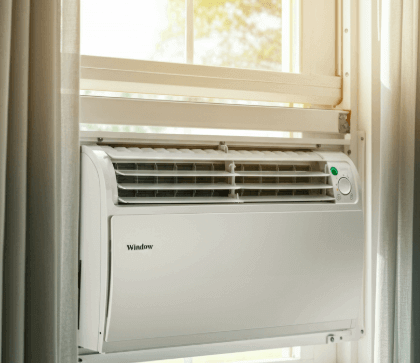With the sweltering summer heat, window air conditioners have become essential in many households. However, one common question often arises: “How many amps does a window AC use?” Understanding the electric consumption of your window air conditioner is crucial for ensuring safety, energy efficiency, and optimal performance. This detailed guide will explore the various factors that influence the amperage draw of window AC units, providing a comprehensive answer to the question, “How many amps does a window AC use?” Whether considering a new purchase or simply seeking to optimize your current setup, this blog will equip you with the knowledge you need.
When evaluating the amps a window AC uses, several key factors must be considered. Real estate investors Steve Daria and Joleigh emphasize the importance of understanding the unit’s size, efficiency rating, and electrical capacity of the property. By considering these elements, you can ensure that your window AC operates safely and efficiently, avoiding potential electrical issues.
Why Amp Usage Matters
Understanding how many amps a window AC unit uses is pivotal for several reasons:
Energy Efficiency
Lower amp usage in window AC units directly correlates with reduced energy consumption, leading to lower energy bills for homeowners.
This not only saves money but also reduces the property’s carbon footprint, making it more appealing to environmentally conscious buyers seeking sustainable living options.

Highlighting the energy efficiency achieved through lower amp usage can enhance the property’s marketability and attract a broader range of potential buyers interested in reducing their overall environmental impact.
Electrical Load Planning
Understanding the amp requirements of window AC units is crucial for effective electrical load planning within a property.
By knowing how many amps each unit draws, homeowners and property managers can make sure that their electrical systems are adequately sized to handle the load without overloading circuits.
Proper load planning prevents electrical issues such as tripped breakers or potential overheating, thereby improving the overall safety and reliability of the property’s electrical infrastructure.
Safety Considerations
Proper electrical planning based on amp requirements plays a vital role in upholding adherence to safety codes and regulations.
By adhering to these standards, property owners mitigate potential hazards associated with electrical overloads or faulty installations, thereby enhancing overall property safety.
Compliance with safety codes not only protects occupants but also boosts the property’s appeal by reassuring buyers of a secure and well-maintained electrical system.
Get An Offer Today, Sell In A Matter Of Days
What is Amperage?
Amperage, often referred to as ‘amps,’ quantifies the electric current flowing through a circuit.
It indicates how much electricity an appliance draws from the electrical system.
For window AC units, understanding amperage is crucial for assessing energy consumption and ensuring compatibility with your property’s electrical infrastructure.
Types of Window AC Units and Their Amp Usage
Window AC units vary in size and cooling capacity, which directly impacts their amp usage. Here are some common types:
- 5,000 BTU Unit: Uses around 5-7 amps
- 10,000 BTU Unit: Uses around 9-10 amps
- 15,000 BTU Unit: Uses around 12-15 amps
Factors Affecting Amp Usage
How many amps does a window AC use? Here are the several factors:
Size of the Unit
The size of a window AC unit directly influences its amp usage: larger units with higher BTU ratings typically require more amps to operate.
This is because they have larger compressors and fans that draw more electrical current to achieve greater cooling capacity.
Homeowners and property managers should consider the size of the space to be cooled when choosing an AC unit, ensuring it matches the cooling needs without unnecessary energy consumption.
Efficiency Ratings
Efficiency ratings, measured by SEER (Seasonal Energy Efficiency Ratio), indicate how effectively a window AC unit converts electricity into cooling power.
Units with elevated SEER ratings are more energy-efficient, meaning they require fewer amps to produce the same amount of cooling as lower-rated units.
Investing in a higher SEER-rated unit not only lessens energy consumption but also lowers operating costs over the lifespan of the AC unit, making it a cost-effective choice for eco-conscious buyers seeking long-term savings.
Electrical Supply
The voltage available in a property, typically 120V or 240V in the United States, significantly impacts the amp requirements of a window AC unit.
Larger units, especially those with higher BTU ratings, may necessitate 240V supply to operate efficiently.
Homeowners should ensure their electrical system can accommodate the voltage and amp requirements of the chosen AC unit to prevent issues such as circuit overloads or inadequate cooling performance.
How to Determine Amps of Your Window AC
How many amps does a window AC use? Here’s how to determine amps of window AC:
- Using a Clamp Meter: This device measures electrical current flowing through a wire. Clamp it around the wire supplying power to your AC unit to get a reading.
- Checking the Manufacturer’s Label: Most AC units have a label that specifies electrical usage, including amperage. This label is typically located on the unit’s back or side.
- Consulting the User Manual: The user manual provides detailed specifications, including amp usage, offering a reliable source of information.

Tips for Managing Amp Usage in Real Estate
How many amps does a window AC use? Here are the tips for managing amp usage:
- Upgrade Electrical Systems: Modernize outdated electrical systems to support the amp requirements of window AC units and other modern appliances.
- Strategic Use of Multiple Units: Distribute the electrical load by using multiple smaller AC units rather than one large unit.
- Energy-Saving Practices: Encourage practices like maintaining closed windows and doors while the AC is running to maximize efficiency and reduce amp usage.
Conclusion
Understanding how many amps a window AC unit uses is crucial for property buyers, sellers, and investors alike. It influences energy efficiency, electrical planning, and safety measures, all of which contribute to the property’s value and appeal. By grasping the fundamentals of amp usage and implementing practical tips, you can optimize your property’s electrical system and enhance its marketability.
**NOTICE: Please note that the content presented in this post is intended solely for informational and educational purposes. It should not be construed as legal or financial advice or relied upon as a replacement for consultation with a qualified attorney or CPA. For specific guidance on legal or financial matters, readers are encouraged to seek professional assistance from an attorney, CPA, or other appropriate professional regarding the subject matter.

